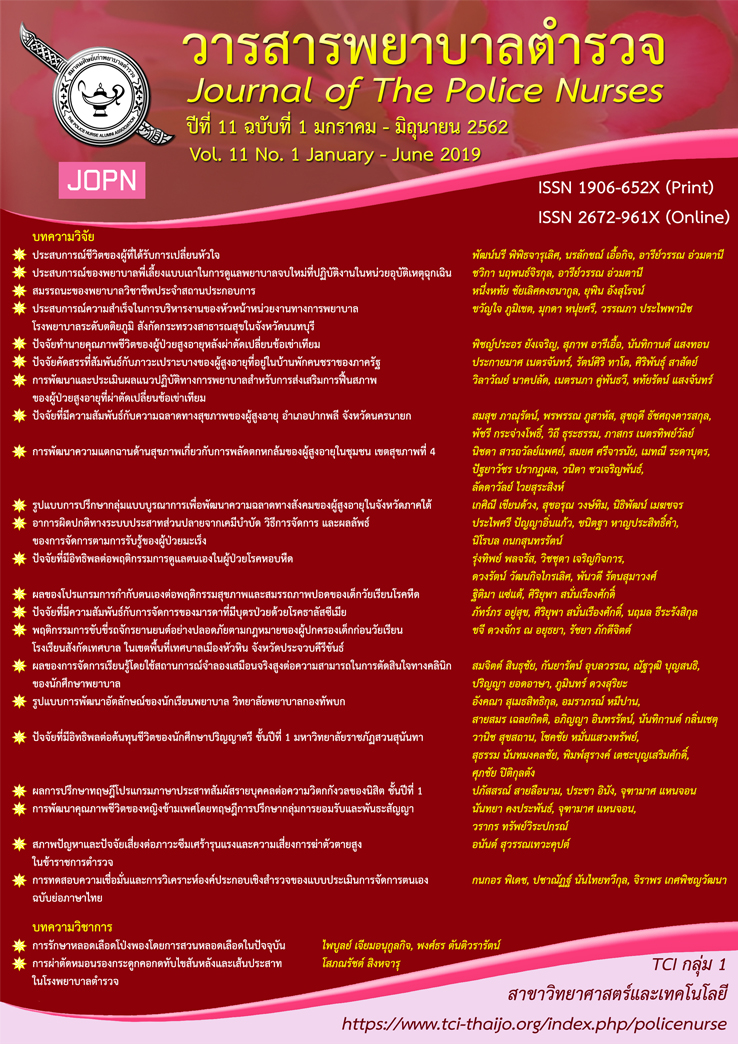ปัจจัยคัดสรรที่สัมพันธ์กับภาวะเปราะบางของผู้สูงอายุที่อยู่ในบ้านพักคนชราของภาครัฐ
คำสำคัญ:
ภาวะเปราะบาง, บ้านพักคนชรา, ผู้สูงอายุบทคัดย่อ
การวิจัยครั้งนี้เป็นการวิจัยเชิงบรรยาย มีวัตถุประสงค์เพื่อศึกษาภาวะเปราะบางของผู้สูงอายุที่อยู่ในบ้านพักคนชราภาครัฐ และศึกษาความสัมพันธ์ระหว่างปัจจัยคัดสรร คือ อายุ เพศ โรคร่วม ภาวะซึมเศร้าและการสนับสนุนทางสังคม กับภาวะเปราะบางในผู้สูงอายุที่อยู่ในบ้านพักคนชราของภาครัฐ เขตกรุงเทพมหานครและปริมณฑล ตัวอย่างได้มาจากการเลือกตามสะดวกจากบ้านพักคนชราของภาครัฐในเขตกรุงเทพมหานครและปริมณฑลที่มีทั้งเพศชายและเพศหญิง ทั้งหมด 3 แห่ง จำนวน 150 คน เครื่องมือที่ใช้ในงานวิจัย คือ แบบประเมินภาวะซึมเศร้า แบบสอบถามการสนับสนุนทางสังคม และแบบประเมินภาวะเปราะบางที่ผ่านการตรวจสอบโดยผู้ทรงคุณวุฒิ มีค่าความเที่ยงเท่ากับ .80, .83, และ.80 ตามลำดับ ส่วนแบบประเมินภาวะเปราะบางหาความเที่ยงด้วยวิธีการใช้ผู้ประเมินร่วม (inter-rater method) มีค่าความเที่ยงเท่ากับ .96 วิเคราะห์ข้อมูลส่วนบุคคลโดยใช้การแจกแจงความถี่ ร้อยละ ค่าเฉลี่ย ส่วนเบี่ยงเบนมาตรฐาน และวิเคราะห์ความสัมพันธ์โดยใช้สถิติ Binary Logistic Regression
ผลการวิจัยพบว่า ผู้สูงอายุในบ้านพักคนชราของภาครัฐ ในเขตกรุงเทพมหานครและปริมณฑล มีภาวะเปราะบาง ร้อยละ 58.7 โดยอายุมีความสัมพันธ์ทางบวกภาวะเปราะบางของผู้สูงอายุในบ้านพักคนชราของภาครัฐในเขตกรุงเทพมหานครและปริมณฑล อย่างมีนัยสำคัญทางสถิติที่ระดับ .05 โดยอายุที่เพิ่มขึ้น 1 ปี จะมีโอกาสเกิดภาวะเปราะบาง คิดเป็นร้อยละ 10 และการสนับสนุนทางสังคมมีความสัมพันธ์ทางลบกับภาวะเปราะบางของผู้สูงอายุในบ้านพักคนชราของภาครัฐในเขตกรุงเทพมหานครและปริมณฑล อย่างมีนัยสำคัญทางสถิติที่ระดับ .05 โดยผู้สูงอายุที่ได้รับการสนับสนุนทางสังคมเพิ่มขึ้น 1 หน่วย จะมีโอกาสเกิดภาวะเปราะบางลดลงร้อยละ 5
Downloads
เอกสารอ้างอิง
Bergman, H., Béland, F., Lebel, P., Contandriopoulos, A. P., Tousignant, P., Brunelle, Y., ... & Clarfield, M. (1997). Care for Canada's frail elderly population: Fragmentation or integration? Canadian Medical Association Journal, 157(8), 1116-1121.
Brandt, P. A., & Weinert, C. (1985). The PRQ: A social support measure. Nursing research, 30(5), 277-280.
Brown, P. J., Roose, S. P., Fieo, R., Liu, X., Rantanen, T., Sneed, J. R., … & & Avlund, K. (2014). Frailty and depression in older adults: A high-risk clinical population. The American Journal of Geriatric Psychiatry, 22(11), 1083-1095.
Buckinx, F., Reginster, J. Y., Dardenne, N., Beaudart, C., Slomian, J., Gillain, S., ... & Bruyère, O. (2015). Prevalence of frailty in nursing home residents according to various diagnostic tools. Journal of Frailty & Aging, 4(S1), 61.
Chen, C. Y., Wu, S. C., Chen, L. J., & Lue, B. H. (2010). The prevalence of subjective frailty and factors associated with frailty in Taiwan. Archives of gerontology and geriatrics, 50, S43-S47.
Chen, L. J., Chen, C. Y., Lue, B. H., Tseng, M. Y., & Wu, S.C. (2014). Prevalence and associated factors of frailty among elderly people in Taiwan. International Journal of Gerontology, 8(3), 114-119.
Dent, E., & Hoogendijk, E. O. (2014). Psychosocial factors modify the association of frailty with adverse outcomes: A prospective study of hospitalized older people. BMC Geriatrics, 14(1), 108.
Espinoza, S. E., & Fried, L. P. (2007). Risk factors for frailty in the older adult. Clinical Geriatrics, 15(6), 37.
Espinoza, S., & Walston, J. D. (2005). Frailty in older adults: insights and interventions Cleveland.Clinic Journal of Medicine, 72(12), 1105.
Ferrucci, L., Guralnik, J. M., Studenski, S., Fried, L. P.,
Cutler, G. B., & Walston, J. D. (2004). Designing randomized, controlled trials aimed at preventing or delaying functional decline and disability in frail, older persons: A consensus report. Journal of the American Geriatrics Society, 52(4), 625-634.
Fried, L. P., Darer, J. &Walston, J. (2003). Frailty. In C. K. Cassel (Eds.), Geriatric medicine and evidence-based approach (4th ed.) (pp. 1067–1076). New York, NY: Springer-Verlag.
Fried, L. P., Tangen, C. M., Walston, J., Newman, A. B., Hirsch, C., Gottdiener, J., ... & McBurnie, M. A. (2001). Frailty in older adults evidence for a phenotype. The Journals of Gerontology Series A: Biological Sciences and MedicalSciences, 56(3), 146-157.
Fried, L. P., Ferrucci, L., Darer, J., Williamson, J. D., & Anderson, G. (2004). Untangling the concepts of disability, frailty, and comorbidity: Implications for improved targeting and care. The Journals of Gerontology Series A: Biological Sciences and Medical Sciences, 59(3), M255-M263.
Institute of Geriatric medicine. (1999). Mini-mental state examination–Thai version2002 (MMSE-Thai 2002). Bangkok: Ministry of Public Health.
Intanu, N. (2012). Frailty: Situation analysis in community. Medical Journal, 6.7(26), 619-628.
Jaidee, S. (2016). A Study of frailty in older people resided in community, Bangkok (master's thesis of nursing science). Faculty of nursing, Chulalongkorn University, Bangkok.
Jeon, G. S., Jang, S. N., & Park, S. (2012). Social support, social network, and frailty in Korean elderly. Journal of the Korean Geriatrics Society, 16(2), 84-94.
Jürschik, P., Nunin, C., Botigué, T., Escobar, M. A.,Lavedán, A., & Viladrosa, M. (2012). Prevalence of frailty and factors associated with frailty in the elderly Population of Lleida, Spain: The FRALLE survey. Archives of Gerontology and Geriatrics, 55(3), 625-631.
Kojima, G. (2015). Prevalence of frailty in nursing homes:A systematic review and meta-analysis. Journal of the American Medical Directors Association, 16(11), 940-945.
Kwong, E. W. Y., Lai, C. K. Y., & Chan, K. S. (2014). Factors associated with quality of life in nursing home residents with frailty. Clinical Nursing Studies, 2(2), p1.
Levers, M. J., Estabrook, C. A., & Ross Kerr, J. C. (2006). Factors contributing to frailty: Literature review. Journal of Advanced Nursing, 56(3), 282-291.
Li, C. M., Chen, C. Y., Li, C. Y., Wang, W. D., & Wu, S. C. (2010). The effectiveness of a comprehensive geriatric assessment intervention program for frailty in community - dwelling older people: A randomized, controlled trial. Archives of Gerontology and Geriatrics, 50, S39-S42.
Ng, T. P., Feng, L., Nyunt, M. S. Z., Larbi, A., & Yap, K. B. (2014). Frailty in older persons: Multisystem risk factors and the frailty risk index (FRI). Journal of the American Medical Directors Association, 15(9), 635-642.
Puts, M. T., Lips, P., Ribbe, M. W., & Deeg, D. J. (2005). The effect of frailty on residential/nursing home admission in the Netherlands independent of chronic diseases and functional limitations. European Journal of Ageing, 2(4), 264-274.
Rockwood, K., Andrew, M., & Mitnitski, A. (2007). A comparison of two approaches to measuring frailty in elderly people. The Journals of Gerontology Series A: Biological Sciences and Medical Sciences, 62(7), 738-743.
Romero-Ortuno, R., Walsh, C. D., Lawlor, B. A., & Kenny, R. A. (2010). A frailty instrument for primary care: findings from the survey of health, ageing and retirement in Europe (SHARE). BMC Geriatrics, 10(57), 1- 12.
Runzer-Colmenares, F. M., Samper-Ternent, R., Al Snih, S., Ottenbacher, K. J., Parodi, J. F., & Wong, R. (2014). Prevalence and factors associated with frailty among Peruvian older adults. Archives of gerontology and geriatrics, 58(1), 69-73.
Srinivas-Shankar, U. & Wu, F. (2009). Frailty and muscle function: Role for testosterone? Basel Karger, 37(10), 133-149.
Sungkamontorn, S. (2006). Selected factors related to adjustment to illness of chronically ill elderly patients, out-patient department, upper part of southern region (Master's thesis Nursing Science). Faculty of nursing, Chulalongkorn University, Bangkok.
Train The Brain Forum Committee. (1994). Thai Geriatric Depression Scale. Siriraj Medical Journal, 46(1), 1-9.
Topinková, E. (2008). Aging, disability and frailty. Annals of Nutrition and Metabolism, 52(1), 6-11.
Woo, J., Goggins, W., Sham, A., & Ho, S. C. (2005). Social determinants offrailty. Gerontology, 51(6), 402-408.
ดาวน์โหลด
เผยแพร่แล้ว
รูปแบบการอ้างอิง
ฉบับ
ประเภทบทความ
สัญญาอนุญาต
ผลงานที่ได้ตีพิมพ์แล้วจะเป็นลิขสิทธิ์ของวารสารพยาบาลตำรวจ















